关于Thread的构造在JDK文档中如下:
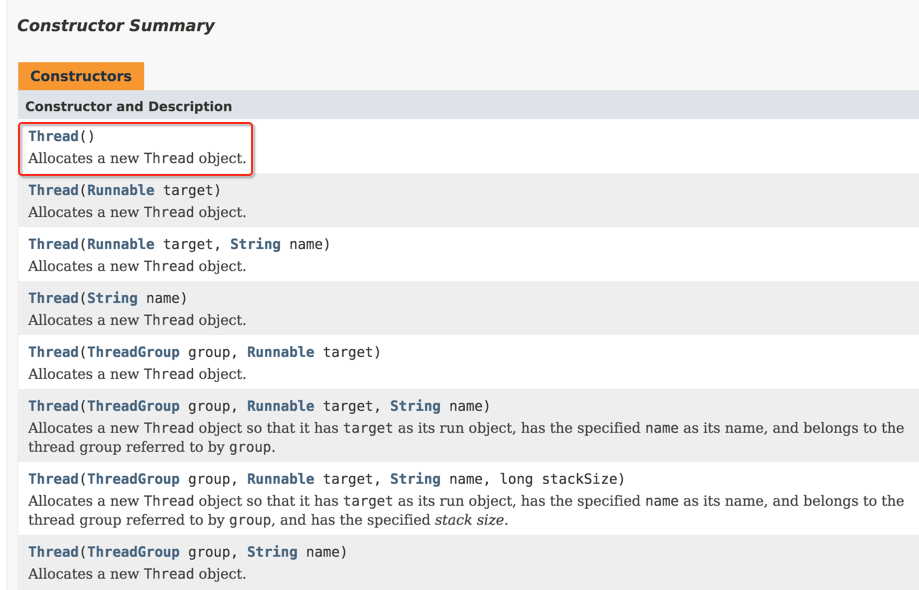
之后会把上面所有的构造都会学习到,这次主要是去研究一下图上标红的默认构造,当然大家肯定对于它都有些不屑,这有啥可学的,不new一个然后start线程不就启动了,属于线程最最基础的东东,然后它的背后并非我们都知道,所以下面开始学习。
Thread常规知识:
先来看一下默认构造的源码:

先了解一下默认线程名的起名规则,看下nextThreadNum():

原来是有一个静态计数的变量,那也就是说默认new出来的线程是以"Thread-0、Thead-1"这样的规则来命名的,用代码来验证下:
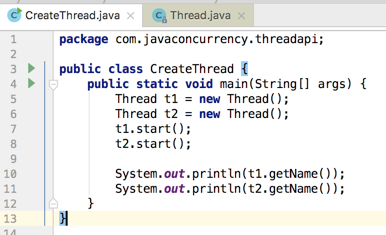
编译运行:

果真如预期,但是目前线程中并未做任何事情,而我们知道可以给线程构造中传一个Runnable接口:
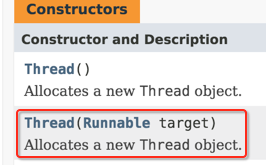
那在默认构造Thread的时候有没有一个空的Runnable去执行呢?看源码【贴出关键代码】:
public Thread() { init(null, null, "Thread-" + nextThreadNum(), 0); } private void init(ThreadGroup g, Runnable target, String name, long stackSize) { init(g, target, name, stackSize, null); }
从代码中可以看到并未自动创建一个Runnable,而是直接传的null,那最终在init()中是如何搞的呢?
private void init(ThreadGroup g, Runnable target, String name, long stackSize, AccessControlContext acc) { if (name == null) { throw new NullPointerException("name cannot be null"); } this.name = name.toCharArray(); Thread parent = currentThread(); SecurityManager security = System.getSecurityManager(); if (g == null) { /* Determine if it's an applet or not */ /* If there is a security manager, ask the security manager what to do. */ if (security != null) { g = security.getThreadGroup(); } /* If the security doesn't have a strong opinion of the matter use the parent thread group. */ if (g == null) { g = parent.getThreadGroup(); } } /* checkAccess regardless of whether or not threadgroup is explicitly passed in. */ g.checkAccess(); /* * Do we have the required permissions? */ if (security != null) { if (isCCLOverridden(getClass())) { security.checkPermission(SUBCLASS_IMPLEMENTATION_PERMISSION); } } g.addUnstarted(); this.group = g; this.daemon = parent.isDaemon(); this.priority = parent.getPriority(); if (security == null || isCCLOverridden(parent.getClass())) this.contextClassLoader = parent.getContextClassLoader(); else this.contextClassLoader = parent.contextClassLoader; this.inheritedAccessControlContext = acc != null ? acc : AccessController.getContext(); this.target = target; setPriority(priority); if (parent.inheritableThreadLocals != null) this.inheritableThreadLocals = ThreadLocal.createInheritedMap(parent.inheritableThreadLocals); /* Stash the specified stack size in case the VM cares */ this.stackSize = stackSize; /* Set thread ID */ tid = nextThreadID(); }
只看核心代码,可以看到将Thread的成员变量target赋值为null了,
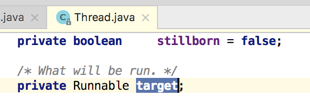
那此时我们执行创建的线程会调用start()方法,那接着看下它:
public synchronized void start() { /** * This method is not invoked for the main method thread or "system" * group threads created/set up by the VM. Any new functionality added * to this method in the future may have to also be added to the VM. * * A zero status value corresponds to state "NEW". */ if (threadStatus != 0) throw new IllegalThreadStateException(); /* Notify the group that this thread is about to be started * so that it can be added to the group's list of threads * and the group's unstarted count can be decremented. */ group.add(this); boolean started = false; try { start0(); started = true; } finally { try { if (!started) { group.threadStartFailed(this); } } catch (Throwable ignore) { /* do nothing. If start0 threw a Throwable then it will be passed up the call stack */ } } } private native void start0();
最终转到C层去执行线程的启动了,而底层的代码暂且不深纠了,这里要知道C层会去调用Thread的run()方法,所以转到run方法去看一眼:
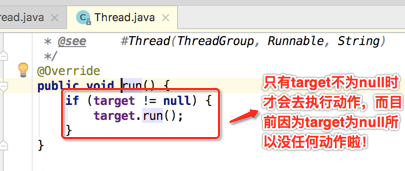
但是!!!可以重写它的run方法来执行我们的动作,如下:
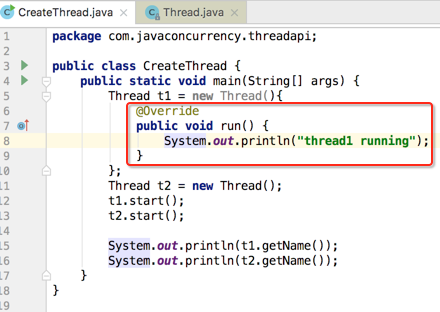
编译运行:

那接着修改代码:

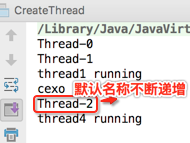
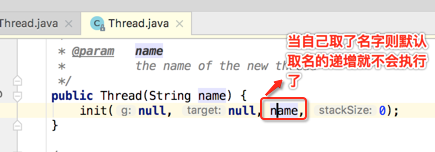
接着在创建runnable的时候也手动给它取个名字,如下:
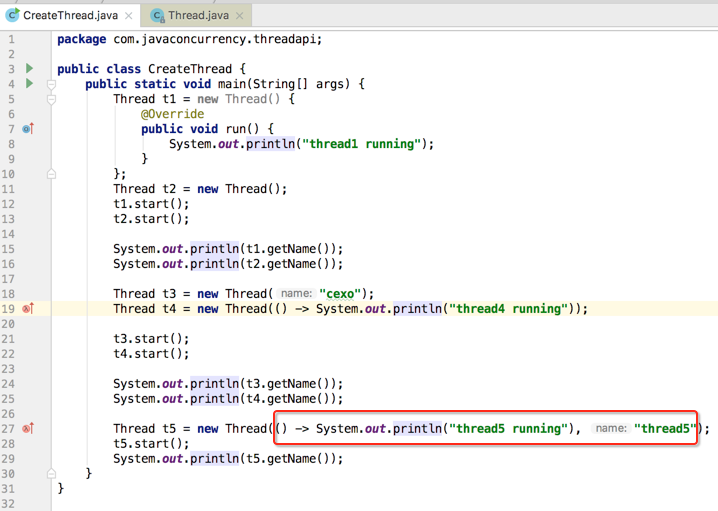

这样关于Thread的构造就学习了四种了,当然也是最经常使用的,比较简单:
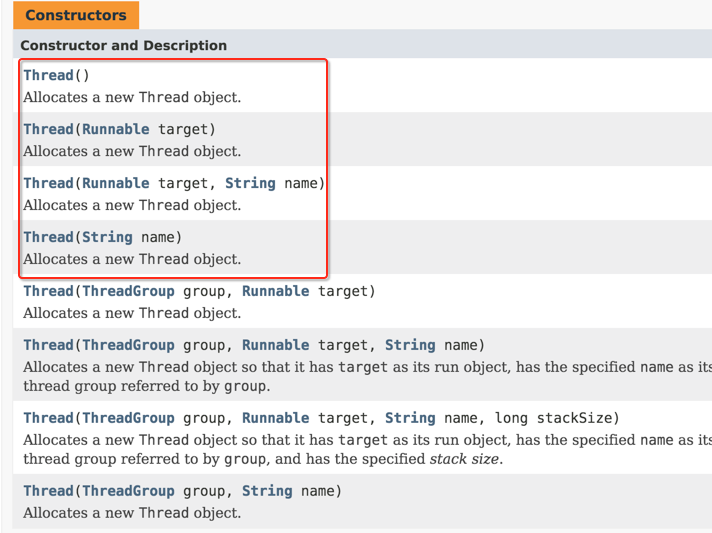
ThreadGroup的概念及守护线程初探:
关于这个内容可能就不是太清楚啦,可以看一下剩下线程构造函数中:

全是跟ThreadGroup相关,貌似实际工作中完全木有接触过它,所以说首先得了解它,从哪了解呢,直接从源码:
public Thread() { init(null, null, "Thread-" + nextThreadNum(), 0); } private void init(ThreadGroup g, Runnable target, String name, long stackSize, AccessControlContext acc) { if (name == null) { throw new NullPointerException("name cannot be null"); } this.name = name.toCharArray(); Thread parent = currentThread(); SecurityManager security = System.getSecurityManager(); if (g == null) { /* Determine if it's an applet or not */ /* If there is a security manager, ask the security manager what to do. */ if (security != null) { g = security.getThreadGroup(); } /* If the security doesn't have a strong opinion of the matter use the parent thread group. */ if (g == null) { g = parent.getThreadGroup(); } } /* checkAccess regardless of whether or not threadgroup is explicitly passed in. */ g.checkAccess(); /* * Do we have the required permissions? */ if (security != null) { if (isCCLOverridden(getClass())) { security.checkPermission(SUBCLASS_IMPLEMENTATION_PERMISSION); } } g.addUnstarted(); this.group = g; this.daemon = parent.isDaemon(); this.priority = parent.getPriority(); if (security == null || isCCLOverridden(parent.getClass())) this.contextClassLoader = parent.getContextClassLoader(); else this.contextClassLoader = parent.contextClassLoader; this.inheritedAccessControlContext = acc != null ? acc : AccessController.getContext(); this.target = target; setPriority(priority); if (parent.inheritableThreadLocals != null) this.inheritableThreadLocals = ThreadLocal.createInheritedMap(parent.inheritableThreadLocals); /* Stash the specified stack size in case the VM cares */ this.stackSize = stackSize; /* Set thread ID */ tid = nextThreadID(); }
从源码中可以看到,默认无参的构造函数并未指定ThreadGroup,当在执行init()方法时发现没有ThreadGroup,则会获得父线程的ThreadGroup,而父线程可以通过currentThread()方法获取,而我们在之前【http://www.cnblogs.com/webor2006/p/7682063.html】有介绍过,对于创建一个线程实际是有两个线程,其中有一个就是main线程,也就是用来启动我们自己创建的线程的,那是不是我们线程的parent就是main呢?下面来做实验论证:


那如果此时新建一个线程,然后再看一下它的ThreadGroup,如下:


那说明创建线程时未指定ThreadGroup,那会以父线程的ThreadGroup作为该线程的ThreadGroup,刚好跟源码逻辑吻和,那是不是说子线程将和父线程在同一个ThreadGroup中?也就是说目前ThreadGroup中应该包含了2个线程,那我们打印看一下:

编译运行:

这是在MAC上的表现,但是!!!如果在windows平台其输出并非如我们所预期的,下面在windows下运行看一下结果:
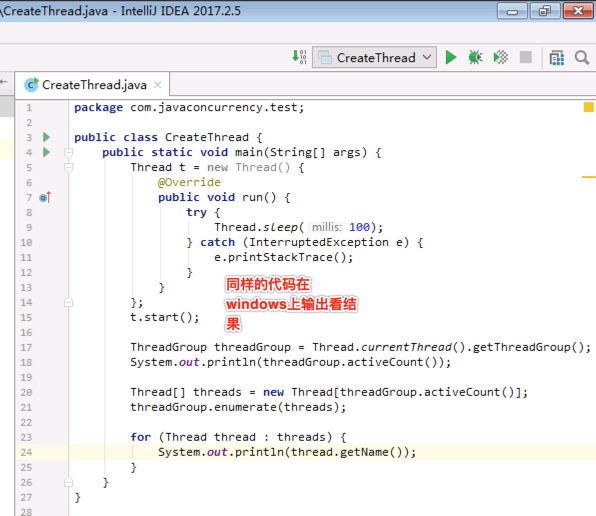

总结:
- 创建线程对象Thread,默认有一个线程名,以Thread-开头,从0开始计数:Thread-0、Thread-1、Thread-2等。
- 如果在构造Thread()的时候没有传递Runnable或者没有复写Thread的run方法,该Thread将不会调用任何东西;如果传递了Runnable接口的实例,或者复写的Thread的run方法,则会执行该方法的逻辑单元(逻辑代码)。
- 如果构造线程对象时未传入ThreadGroup,Thread会默认获取父线程的TreadGroup作为该线程的ThreadGroup,此时子线程将和父线程在同一个ThreadGroup中。